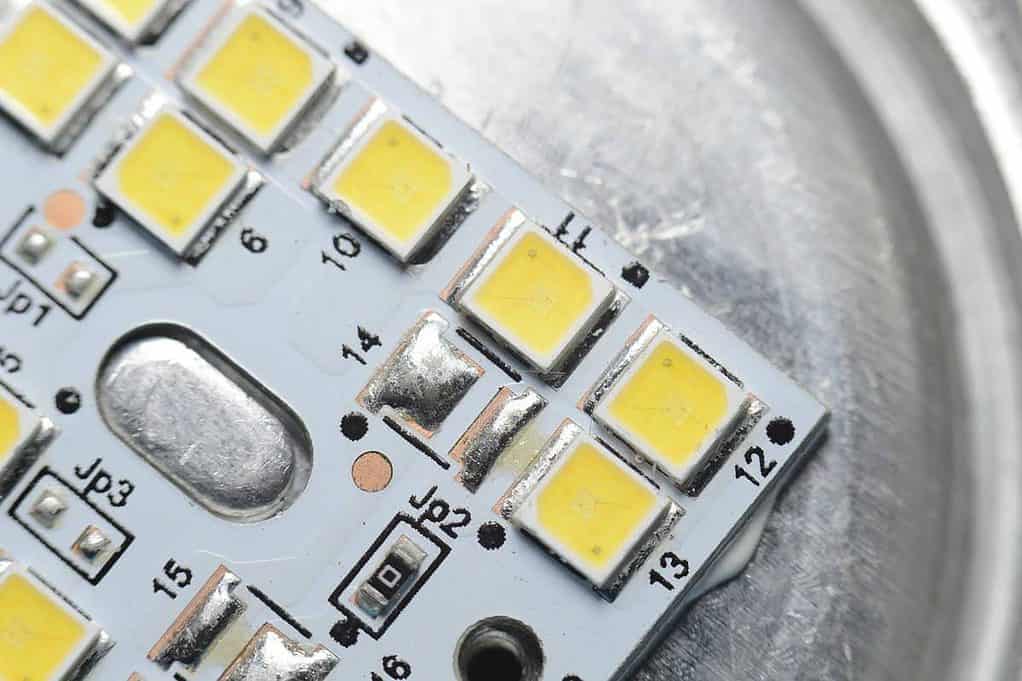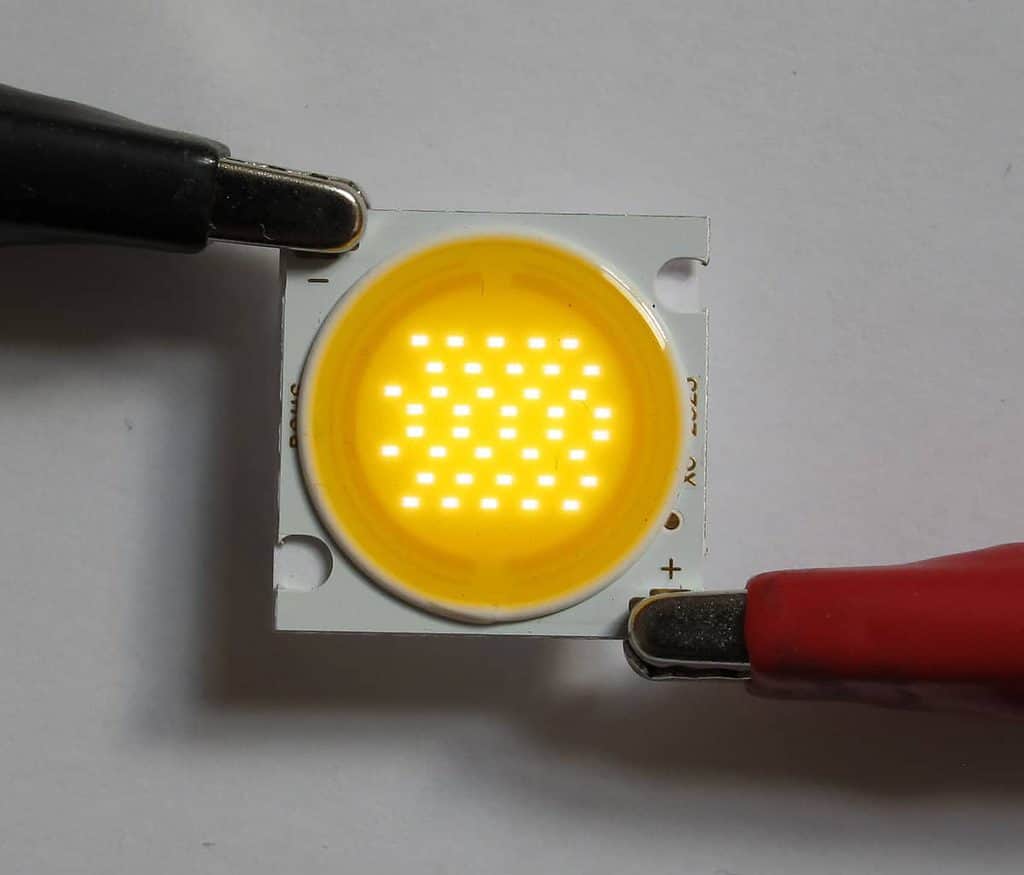LED lights come in different varieties and are used in various applications. The two main types of LED downlights are the surface mount diode (SMD) downlights and chip on board (COB) downlights, which have unique advantages. Let’s now dig deeper into each of these two lighting options.
What is SMD LED?
SMD (Surface-mounted devices) is a led chip mounted on the surface of a PCB (printed circuit board). They are produced using surface mount technology (SMT).
The technology used in making these lights makes them applicable in many areas, including bulbs and filament lights. And did you know that the notification light on your phone is also SMD LED light? The light that you see after you get a notification on your phone is an SMD light.
One of the distinguishing features of the SMD chips is the number of connections and diodes. Also, you can find more than three diodes and more than two contacts on a single chip, with each one of them having its own circuit.
The chips produce multiple color effects, including the primary colors, green, red, and blue. You can produce any color with these three diodes by adjusting the beam angle.

Why Choose SMD?
SMD LEDs are one of the most common types of lighting that we have today. They are used in many outdoor applications to provide adequate lighting and are also energy efficient. That said, here are other benefits of these lights;
- They come in different shapes, and designs
One of the main advantages of these lights is that they come in different designs, shapes, and sizes. They have intricate designs, such as the SMD 2835, SMD 3030. SMD 3014, SMD 5050, with a width of 3.5mm, 3.0mm, 2.8mm, and 5 mm, respectively.
As mentioned above, the chips used to make these lights are tiny and built on a flat rectangular-shaped object. Their small size makes them more adaptable and ideal for retrofitting.
- They have a larger beam angle
SMD LEDs don’t rely on an epoxy covering to focus their light. As a result, they offer a larger beam angle compared to ordinary LEDs. Its beam angle is around 110 degrees in the horizontal and more than 120 degrees viewing angle in the vertical direction.
The wide beam angle of these lights makes them ideal for many applications, including floodlights, building LED facade lighting, and spotlights.
- They have a good light distribution and mixing
SMD can produce different light color outputs at different beam angles, including red, blue, and green. When adjusted to different angles, they produce multiple color effects.
The output of these lights is about 50-100 lumens per watt which makes them produce bright light.
- Easy to install
The design of the aluminum alloy material box’s structure is incredibly light. Due to their architectural structure, the SMD lights are small and very easy to install.
Let us look into COB LED lights now that you have learned about SMD LED lighting and its perks.
What is COB LED?
COB (Chip on board) is an LED chip in direct contact with a substrate such as silicon carbide or sapphire. The chips are closely packed next to each other. COB has multiple diodes, with a minimum of 9, on the printed circuit board, 1 circuit, and two contacts.
Additionally, the chips in this type of lighting are arranged in parallel form or a specific series depending on the printed circuit board. As a result, these lights have a panel-like appearance.
COB lights have a heat sink that is made of aluminum. The heat sink is used to dispel the heat produced by the lights.

Why Choose COB?
COB LED lights are used in numerous applications, including street lighting, playground lighting, light strip, downlights, landscape lighting, and high bay lighting, to mention a few. So why do people use this type of LED lighting? Read on.
- Better lighting effect
COB lights have a better lighting effect and produce a bright, high-quality light. Due to its chip design, it can incorporate more LED chips resulting in glare-free uniform lighting.
- Better heat efficiency and lumen per watt ratio
COB lights have an improved lumen per watt ratio and better heat efficiency due to their design. They produce more lumens of above 80 using less energy.
- Better heat distribution
COB LEDs have a small number of components and a large cooling area. The thermal sink on the COB is aimed at the circuit board. Also, the substrate material, board circuit, and heat sink components are responsible for the COB LED’s heat dispersion efficiency.
The next question that comes across your mind is: what similarities do they have, and what differentiates them, right? Well, let’s find out.
What Are the Similarities Between SMD and COB?
SMD lights and COB lights have some similarities, which make them popular lighting options. Some of them include;
- They both have a very simple design
- They have more than two diodes
- They produce bright lighting- COB lights produce above 80 lumens per watt, whereas SMD lights produce 50 to 100 lumens per watt.
- They are energy efficient- The energy consumption for these lights is relatively low as they produce more lumens per watt.
- They are cost-effective. Although the initial installation costs might be high, you get to save a lot on the cost as they do not require regular maintenance and can serve you for more than 50,000 hours.
- They can be used in many applications such as spotlights, floodlights, high bay lights, etc.
Let us now look at some of the differences between COB and SMD.
What is The Difference Between SMD and COB?
While both of these lights have similarities, they also have differences that distinguish them. Below is a table that shows some of the common differences between them;
| SMD LED lights | COB LED lights | |
| Number of diodes | They have up to 3 diodes | They have multiple diodes, 9 or more |
| Appearance | They appear like a collection of smaller lights | They have a panel appearance |
| Quality of light | SMD lights feature some glare. | They are glare-free and provide more uniform illumination. |
| Color temperature | The color temperature of the SMD varies from the primary red, green, and blue. The output can also be adjusted to produce different color temperatures. | They are not flexible when it comes to color temperatures. They produce a single color temperature. |
| Lumens per watt ratio | They produce a range of 50-100 lumens per watt | They have a higher output range of above 80 lumens per watt |
| Size of the heat sink | They have a small heat sink | They have a big heat sink |
| Technology | They require mounting then reflow soldering on the PCB | It does not require any mounting or reflow soldering |
| Manufacturing costs | The manufacturing costs are quite high. The manufacturing and labor costs account for almost 15% of the material cost | The manufacturing costs are lower. The manufacturing and labor costs account for almost 10% of the material cost |
Which One to Choose: SMD or COB?
The type of lighting option you decide to choose will depend on various factors, including the light’s efficiency, brightness, cost-effectiveness, and application.
Both lights are reliable, produce bright light, and are energy efficient. For instance, if you want more brightness, you will have to go for COB, which has a wide lumen output range, about 80 and above lumens per watt.
The application of these lights is also something that you need to look into. While both can be used in numerous places, their specific features are what differentiates them. SMD lights, for example, can be the best fit in the bathroom area, kitchen, and spaces that may require different color temperatures. On the other hand, you can use COB lights in streetlights, industrial lighting, high bay lighting, etc.
Conclusion
LED lights are without a doubt a game-changer when it comes to lighting technology. Although the initial cost for installing LED lights is high, it is a good investment as they will serve you for a long time and still maintain their brightness.
They can save you to up to 80% energy costs and last you for 5+ years without needing any replacement or regular maintenance. They also produce bright light and are long-lasting.
We hope that this article has answered some of the questions you might have had about SMD and COB lighting. Both of them are excellent options and what differentiates them is their features and application areas.





